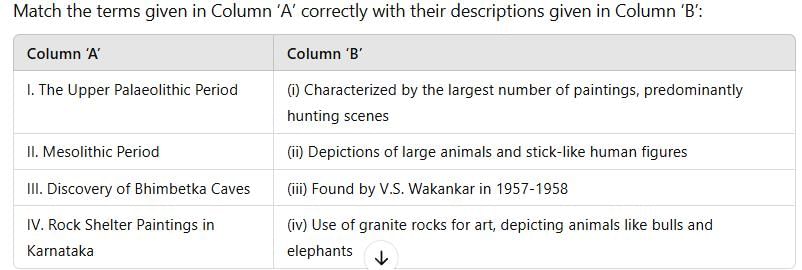Test: Prehistoric Rock Paintings- 1 - Year 5 MCQ
15 Questions MCQ Test - Test: Prehistoric Rock Paintings- 1
Which materials were commonly used to create prehistoric paints?
i. Rocks and minerals
ii. Animal fat or gum to make the paint sticky
iii. Modern-day brushes for applying paint
iv. Colors like red from haematite and green from chalcedony
i. Rocks and minerals
ii. Animal fat or gum to make the paint sticky
iii. Modern-day brushes for applying paint
iv. Colors like red from haematite and green from chalcedony
Where have remnants of rock paintings been found?
Assertion (A): The prehistoric rock art of India reflects the cultural and spiritual lives of our ancestors.
Reason (R): This art form has remained unchanged for thousands of years, signifying a lack of artistic evolution.
What were the brushes used by the artists of Bhimbetka made of?
What is true about the rock shelters of Bhimbetka?
i. They contain paintings of human figures, animals, and daily life activities.
ii. They were discovered by V.S. Wakankar in 1957-1958.
iii. The rock shelters are modern-day art sites.
iv. The paintings depict the construction of pyramids.
Statement I: The Mesolithic Period is known for smaller paintings with multiple themes, particularly focusing on hunting scenes.
Statement II: The Upper Palaeolithic Period in Indian rock art featured large-scale depictions of daily life activities such as fruit gathering and food preparation.
Who was responsible for the discovery of the first rock paintings in India?
Assertion (A): The Upper Palaeolithic period is characterized by the depiction of large animals and stick-like human figures in rock paintings.
Reason (R): The Mesolithic period is noted for a greater variety of themes, primarily focused on hunting scenes.
Assertion (A): The rock art at Bhimbetka is categorized into seven distinct historical periods.
Reason (R): Each period reflects a unique style and technique, illustrating the evolution of art through time.
Arrange the following events in chronological order:
- Discovery of the first rock paintings in India by Archibald Carlleyle.
- The Mesolithic Period, characterized by the largest number of paintings.
- The Upper Palaeolithic Period with depictions of large animals.
- Discovery of Bhimbetka Caves by V.S. Wakankar.
Assertion (A): The rock paintings found in India date back to the Upper Palaeolithic era and depict a variety of subjects including animals and human figures.
Reason (R): The first rock paintings in India were discovered in 1867-1868 by archaeologist Archibald Carlleyle, which indicates that their existence was recognized only in the modern era.
What did Upper Palaeolithic artists commonly depict in their art?
i. Large animals like rhinos and tigers
ii. Detailed landscapes with rivers and mountains
iii. Stick-like human figures
iv. Green and red colors for different scenes
What is the location of the rock shelters that bear paintings on the banks of the River Suyal?
What themes are often found in Mesolithic art?
i. Hunting scenes
ii. Building monuments
iii. Depictions of community dances
iv. Detailed portraits of people




















